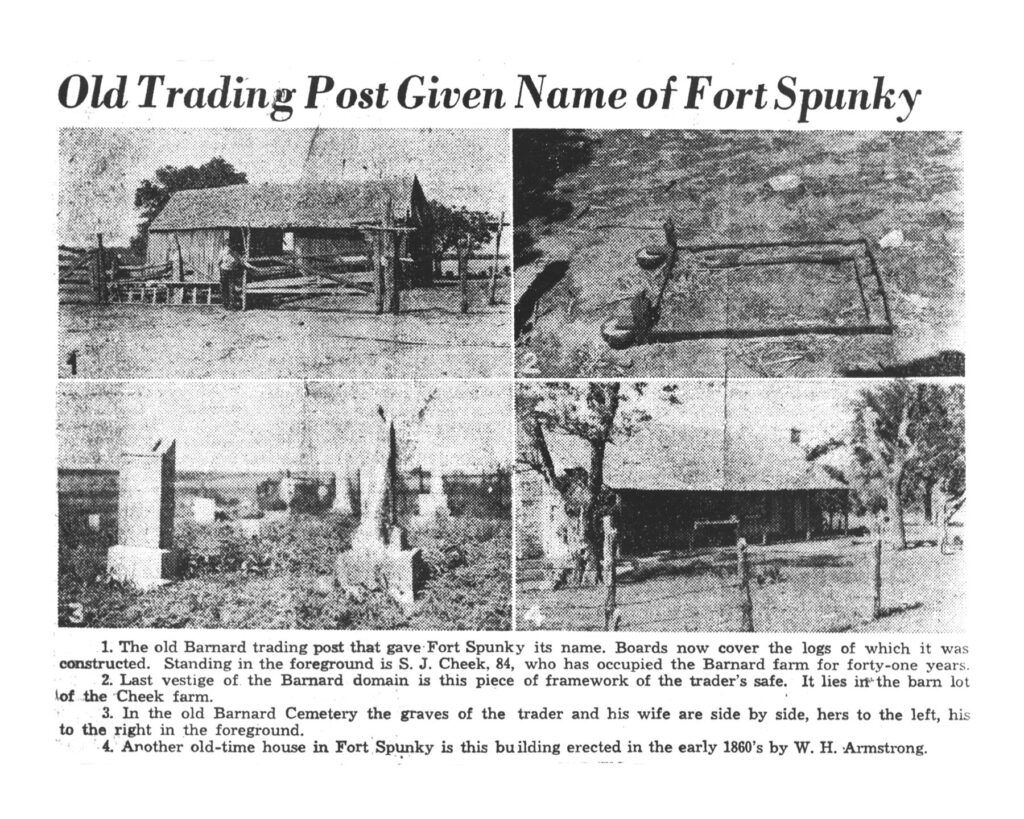FORT SPUNKY
Contributed by Barbara K. Armstrong Williams
From Hood County News ~1938-1941

This newspaper clipping was saved by my uncle who is no longer living. My dating of the article at 1940 or 1941 comes from the age of Samuel J. Cheek, my great-grandfather, who is in the picture. The newspaper states he is 84 at the time of printing. He was born August 1, 1856 and died March 9, 1942. It also says he had occupied the land for 41 years. However, on page 7 in the book Of a People and a Creek it is stated that he bought the land in 1897, so that could make it as early as 1938 for the printing of the newspaper article. Sam Cheek bought the land from the Barnard’s as I understand.
You will see that this photograph bears little resemblance to the drawing in the article about Juana Barnard on the Hood County web page or the description in the article from the Hood County News also from the web page (as copied below). I was told the building had the porch and shed removed from it and was covered in boards, so there are no windows showing and no chimneys. It was used as a corn shed, etc. in later years.
To me the significance of this newspaper clipping is that there may not have been many photographs taken of the trading post and, even with its poor quality, it is at least an actual picture though not in its original state.
Description of Trading Post from the Hood County Web Page
Hood County News, Wednesday, April 22, 1998
Historic Trading Post Due State Marker
Here’s what the Hood County Trading Post looked like:
The trading house was a 1½ story dog-run with two 24 x 24 rooms separated by a 14-foot wide hall. The flooring was made of split cottonwood logs cut from the Brazos River bottoms and the roof was covered with cottonwood shingles.
A stone fireplace and chimney, flanked by windows at ground level, were located on each end of the building. The foundation consisted of large limestone rocks. A 12-foot porch extended the front of the building, while a 16-foot wide shed ran the length of the building in back. All the windows had louvered shutters and the house was enclosed by a rail fence.
ADDENDUM
Subject: Trading Post
Date: Mon, 17 Jan 2000 08:44:01 -0600
From: Vircy Macatee
To: Frank Saffarrans
Frank:
Just read the aritle on the “Fort Spunky Trading Post” written by Barbara Armstrong Williams with the picture from 1938 – 1941.
There was no “Fort Spunky Trading Post”; it was “Barnard Trading Post”. If you will check with O C Cheek who is the grand son of Sam Cheek and owns the property now, you will learn that it should be called “Barnard Trading Post because it was owned by Charlie Barnard during its entire use as a trading post.
When information is posted that is incorrect, it should be corrected; not posting a correction somewhere were it will never be found.
vbm
_________________________________________________________
Subject: Fort Spunky
Date: Tue, 18 Jan 2000 15:24:02 -0600
From: Vircy Macatee
To: Frank Saffarrans
Frank:
I have found a little more information on Fort Spunky. It did not come into existence as a village until 1870; however, I can remember that it had a store, a post office and a gin plus maybe one or two other small stores. It was built around three 90 degree curves going from the Craig Crossing into Mitchell Bend and on to George’s Creek. I think it might have been some type of village until about the 1940’s at the end of WWII.
The Barnard Trading Post was about 1 1/2 miles north of this village and was no longer used as a Trading Post after the 1860’s when the last of the Indians were removed from this area. The Barnard Trading Post was privately owned by George and Charlie Barnard and never developed into more than a trading post where they lived.. By this time, Charlie had moved to Glen Rose and built and operated the mill.
When it first began to develop with the early settlers trying to set up a store for supplies, it might have been called Barnardsville; but I have never found any records to verify that.
vbm
